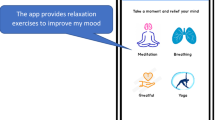Abstract
Behaviour changes and persuasive mobile health (mHealth) technologies have shown success in motivating people to be more active and engage in physical activity. Research has demonstrated that persuasive interventions perform better if they are theory-driven and personalized. Thus, various research has addressed personalizing mHealth technologies based on different aspects. However, the literature lacks studies on the moderating effect of personality traits on the determinants of physical activity as identified by the Health Belief Model. To fill this gap, we conducted a large-scale study of 430 participants’ physical activity behaviour, associated determinants, and individuals’ personality traits. We developed a general model showing how the determinants impact physical activity and a personality-based model exploring the moderating effect of personality. Then, we explored the differences between the two models, as well as between distinct personalities within the personality-based model. Our findings show that people of distinct personalities respond differently to the behaviour change determinants. Based on the results, the paper provides recommendations for designing personalized persuasive mHealth interventions for promoting physical activity.
Access this chapter
Tax calculation will be finalised at checkout
Purchases are for personal use only
Similar content being viewed by others
References
Almutari, N., Orji, R.: Culture and health belief model: exploring the determinants of physical activity among Saudi adults and the moderating effects of age and gender. In: Proceedings of the 29th ACM Conference on User Modeling, Adaptation and Personalization, UMAP 2021, pp. 138–146 (2021). https://doi.org/10.1145/3450613.3456826
Alslaity, A., Tran, T.: The effect of personality traits on persuading recommender system users. In: Joint Workshop on Interfaces and Human Decision Making for Recommender Systems, IntRS 2020, pp. 48–56 (2020)
Alslaity, A., Tran, T.: Users’ responsiveness to persuasive techniques in recommender systems. Front. Artif. Intell. 4 (2021). https://doi.org/10.3389/FRAI.2021.679459
Arteaga, S.M., González, V.M., Kurniawan, S., Benavides, R.A.: Mobile games and design requirements to increase teenagers’ physical activity. Pervasive Mob. Comput. 8(6), 900–908 (2012). https://doi.org/10.1016/J.PMCJ.2012.08.002
Chan, B.C.L., Luciano, M., Lee, B.: Interaction of physical activity and personality in the subjective wellbeing of older adults in Hong Kong and the United Kingdom. Behav. Sci. 8, 8 (2018). https://doi.org/10.3390/BS8080071
Chin, W.: The partial least squares approach to structural equation modeling. Modern Methods Bus. Res. 295(2), 295–336 (1998). Retrieved October 7, 2021 from https://books.google.ca/books?hl=en&lr=&id=EDZ5AgAAQBAJ&oi=fnd&pg=PA295&dq=The+partial+least+squares+approach+for+structural+equation+modeling.+Modern+methods+for+business+research&ots=49sD5nr-ip&sig=KmYZ-1y0JWAlfJF8drlKhZHR2ko#v=onepage&q=Thepartiallea
Consolvo, S., McDonald, D.W., Landay, J.A.: Theory-driven design strategies for technologies that support behavior change in everyday life. In: Proceedings of the Conference on Human Factors in Computing Systems, pp. 405–414 (2009).https://doi.org/10.1145/1518701.1518766
Costello, A., Osborne, J.: Best practices in exploratory factor analysis: four recommendations for getting the most from your analysis. Practical Assess. Res. Eval. 10, 1–7 (2019). https://doi.org/10.7275/jyj1-4868
Anderson, E.S., Wojcik, J.R., Winett, R.A., Williams, D.M.: Social-cognitive determinants of physical activity: the influence of social support, self-efficacy, outcome expectations, and self-regulation among participants in a church-based health promotion study. Health Psychol. Official J. Div. Health Psychol. Am. Psychol. Assoc. 25(4), 510–520 (2006). https://doi.org/10.1037/0278-6133.25.4.510
Fogg, B.J.: Persuasive technology: using computers to change what we think and do. Persuasive Technol. Using Comput. Change What We Think Do 1–282 (2003).https://doi.org/10.1016/B978-1-55860-643-2.X5000-8
Gacek, M., Kosiba, G., Wojtowicz, A., López Sánchez, G.F., Szalewski, J.: Personality-related determinants of physical activity among Polish and Spanish physical education students. Front. Psychol. 12, 6360 (2022). https://doi.org/10.3389/FPSYG.2021.792195
Gefen, D., Straub, D., Boudreau, M.-C.: Structural equation modeling and regression: guidelines for research practice. Commun. Assoc. Inf. Syst. 4(1), 7 (2000). https://doi.org/10.17705/1CAIS.00407
Glanz, K.: Theory at a glance: a guide for health promotion practice (1997). Retrieved October 5, 2021 from https://books.google.ca/books?hl=en&lr=&id=rUXiaSxFT48C&oi=fnd&pg=PA5&dq=Theory+at+a+glance:+A+guide+for+health+promotion+practice&ots=xlqpC3qDpc&sig=RaqlCqM7BUrHLUX30syAkJuege4
Gristwood, J.: Applying the Health Belief Model to Physical Activity Engagement Among Older Adults. Illuminare 9 (2011). Retrieved October 7, 2021 from https://scholarworks.iu.edu/journals/index.php/illuminare/article/view/1035
Hair, J.F., Ringle, C.M., Sarstedt, M.: PLS-SEM: indeed a silver bullet. J. Mark. Theory Practice 19(2), 139–152 (2014). https://doi.org/10.2753/MTP1069-6679190202
Hatami, T., Noroozi, A., Tahmasebi, R., Rahba, A.: Effect of multimedia education on nutritional behaviour for colorectal cancer prevention: an application of health belief model. Malaysian J. Med. Sci. MJMS 25(6), 110 (2018). https://doi.org/10.21315/MJMS2018.25.6.11
Hirsh, J.B., Kang, S.K., Bodenhausen, G.V.: Personalized persuasion: tailoring persuasive appeals to recipients’ personality traits. Psychol. Sci. 23(6), 578–581 (2012). https://doi.org/10.1177/0956797611436349
Hoseini, H., Maleki, F., Moeini, M., Sharifirad, G.R.: Investigating the effect of an education plan based on the health belief model on the physical activity of women who are at risk for hypertension. Iran. J. Nurs. Midwifery Res. 19(6), 647 (2014). Retrieved October 10, 2021 from /pmc/articles/PMC4280731/
Jalilian, F., et al.: Predicting factors related to regular physical activity among Iranian Medical College student: an application of health belief model. Soc. Sci. 3688–3691 (2016). Retrieved October 10, 2021 from https://medwelljournals.com/abstract/?doi=sscience.2016.3688.3691
Jose, R., Narendran, M., Bindu, A., Beevi, N., Manju, L., Benny, P.V.: Public perception and preparedness for the pandemic COVID 19: a health belief model approach. Clin. Epidemiol. Global Health 9, 41–46 (2021). https://doi.org/10.1016/J.CEGH.2020.06.009
Kasser, S.L., Kosma, M.: Health beliefs and physical activity behavior in adults with multiple sclerosis. Disabil. Health J. 5(4), 261–268 (2012). https://doi.org/10.1016/J.DHJO.2012.07.001
Kharrazi, H., Faiola, A., Defazio, J.: Healthcare game design: behavioral modeling of serious gaming design for children with chronic diseases. In: Jacko, J.A. (ed.) HCI 2009. LNCS, vol. 5613, pp. 335–344. Springer, Heidelberg (2009). https://doi.org/10.1007/978-3-642-02583-9_37
Khoi, B.H., Van Tuan, N.: Using SmartPLS 3.0 to analyse internet service quality in Vietnam. In: Anh, L.H., Dong, L.S., Kreinovich, V., Thach, N.N. (eds.) ECONVN 2018. SCI, vol. 760, pp. 430–439. Springer, Cham (2018). https://doi.org/10.1007/978-3-319-73150-6_34
Komatsu, H., Nishio, K.I.: An experimental study on motivational change for electricity conservation by normative messages. Appl. Energy 158, 35–43 (2015). https://doi.org/10.1016/j.apenergy.2015.08.029
Merianos, A.L.: Vigorous physical activity among college students: using the health belief model to assess involvement and social support. Arch. Exerc. Health Dis. 4(2), 267–279 (2014). https://doi.org/10.5628/aehd.v4i2.153
Lemes, Í., et al.: Sedentary behaviour is associated with diabetes mellitus in adults: findings of a cross-sectional analysis from the Brazilian National Health System. J. Public Health (Oxf.) 41(4), 742–749 (2019). https://doi.org/10.1093/PUBMED/FDY169
Luo, Y., Lee, B., Yvettewohn, D., Rebar, A.L., Conroy, D.E., Choe, E.K.: Time for break: understanding information workers’ sedentary behavior through a break prompting system. In: Proceedings of the Conference on Human Factors in Computing Systems, April 2018 (2018). https://doi.org/10.1145/3173574.3173701
Mahindarathne, P.P.: Assessing COVID-19 preventive behaviours using the health belief model: a Sri Lankan study. J. Taibah Univ. Med. Sci. 16(6), 914–919 (2021). https://doi.org/10.1016/J.JTUMED.2021.07.006
Martínez-Ramos, E., et al.: Patterns of sedentary behavior in overweight and moderately obese users of the Catalan primary-health care system. PLoS ONE 13, 1 (2018). https://doi.org/10.1371/JOURNAL.PONE.0190750
McCrae, R.R., John, O.P.: An introduction to the five-factor model and its applications. J. Pers. 60(2), 175–215 (1992). https://doi.org/10.1111/J.1467-6494.1992.TB00970.X
Michie, S., Johnston, M., Francis, J., Hardeman, W., Eccles, M.: From theory to intervention: mapping theoretically derived behavioural determinants to behaviour change techniques. Appl. Psychol. 57(4), 660–680 (2008). https://doi.org/10.1111/J.1464-0597.2008.00341.X
Orji, R., Mandryk, R.L.: Developing culturally relevant design guidelines for encouraging healthy eating behavior. Int. J. Hum. Comput. Stud. 72(2), 207–223 (2014). https://doi.org/10.1016/J.IJHCS.2013.08.012
Orji, R., Mandryk, R.L., Vassileva, J., Gerling, K.M.: Tailoring persuasive health games to gamer type. In: Proceedings of the SIGCHI Conference on Human Factors in Computing Systems (2013).https://doi.org/10.1145/2470654
Orji, R., Nacke, L.E., Di Marco, C.: Towards personality-driven persuasive health games and gamified systems. In: Proceedings of the 2017 CHI Conference on Human Factors in Computing Systems (2017). https://doi.org/10.1145/3025453
Orji, R., Vassileva, J., Mandryk, R.: Towards an effective health interventions design: an extension of the health belief model. Online J. Public Health Inform. 4, 3 (2012). https://doi.org/10.5210/OJPHI.V4I3.4321
Piercy, K.L., et al.: The physical activity guidelines for Americans. JAMA 320(19), 2020–2028 (2018). https://doi.org/10.1001/JAMA.2018.14854
Rammstedt, B., John, O.P.: Measuring personality in one minute or less: a 10-item short version of the big five inventory in English and German. J. Res. Pers. 41(1), 203–212 (2007). https://doi.org/10.1016/J.JRP.2006.02.001
Rhodes, R.E., Rfaeffli, L.A.: Personality and physical activity. In: Acevedo, E. (ed.) The Oxford Handbook of Exercise Psychology, pp. 195–223. Oxford University Press (2012). Retrieved May 30, 2022 from https://books.google.ca/books?hl=en&lr=&id=VR1pAgAAQBAJ&oi=fnd&pg=PA195&dq=personality+and+physical+activity&ots=5Au_6mL0QO&sig=oDlzHOEqc3vhJudLoqIlztewaJ4#v=onepage&q=personalityandphysicalactivity&f=false
Rosenstock, I.M.: Why people use health services. Milbank Q. 83, 4 (2005). https://doi.org/10.1111/J.1468-0009.2005.00425.X
Michie, S., Prestwich, A.: Are interventions theory-based? Development of a theory coding scheme. Health Psychol. Official J. Div. Health Psychol. Am. Psychol. Assoc. 29(1), 1–8 (2010). https://doi.org/10.1037/A0016939
Sallis, R., et al.: Physical inactivity is associated with a higher risk for severe COVID-19 outcomes: a study in 48 440 adult patients. Br. J. Sports Med. 55(19), 1099–1105 (2021). https://doi.org/10.1136/BJSPORTS-2021-104080
Sarstedt, M., Cheah, J.-H.: Partial least squares structural equation modeling using SmartPLS: a software review. J. Mark. Anal. 7(3), 196–202 (2019). https://doi.org/10.1057/S41270-019-00058-3
Sebastião, E., et al.: The international physical activity questionnaire-long form overestimates self-reported physical activity of Brazilian adults. Public Health 126(11), 967–975 (2012). https://doi.org/10.1016/J.PUHE.2012.07.004
Tupes, E.C., Christal, R.E.: Recurrent personality factors based on trait ratings. J. Pers. 60(2), 225–251 (1992). https://doi.org/10.1111/J.1467-6494.1992.TB00973.X
Peng, W.: Design and evaluation of a computer game to promote a healthy diet for young adults. Health Commun. 24(2), 115–127 (2009). https://doi.org/10.1080/10410230802676490
Widiger, T.A., Oltmanns, J.R.: Neuroticism is a fundamental domain of personality with enormous public health implications. World Psychiatry 16(2), 144 (2017). https://doi.org/10.1002/WPS.20411
Young, D.R., et al.: Sedentary behavior and cardiovascular morbidity and mortality: a science advisory from the American Heart Association. Circulation 134(13), e262–e279 (2016). https://doi.org/10.1161/CIR.0000000000000440
Product | SmartPLS. Retrieved October 7, 2021 from https://www.smartpls.com/
Author information
Authors and Affiliations
Corresponding author
Editor information
Editors and Affiliations
Rights and permissions
Copyright information
© 2023 ICST Institute for Computer Sciences, Social Informatics and Telecommunications Engineering
About this paper
Cite this paper
Alslaity, A., Amutari, N., Orji, R. (2023). Personalizing mHealth Persuasive Interventions for Physical Activity: The Impact of Personality on the Determinants of Physical Activity. In: Tsanas, A., Triantafyllidis, A. (eds) Pervasive Computing Technologies for Healthcare. PH 2022. Lecture Notes of the Institute for Computer Sciences, Social Informatics and Telecommunications Engineering, vol 488. Springer, Cham. https://doi.org/10.1007/978-3-031-34586-9_45
Download citation
DOI: https://doi.org/10.1007/978-3-031-34586-9_45
Published:
Publisher Name: Springer, Cham
Print ISBN: 978-3-031-34585-2
Online ISBN: 978-3-031-34586-9
eBook Packages: Computer ScienceComputer Science (R0)




